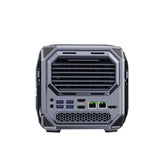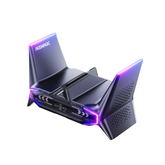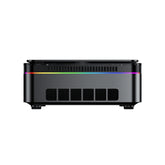DDR5 vs LPDDR5X: Speed, Gaming Performance & Which is Better

As memory technology rapidly evolves, DDR5 and LPDDR5X, the latest generation of memory standards, are at the forefront of performance innovation. However, faced with these two technologies, many users might feel uncertain when it comes to decisions about speed, gaming performance, and choices for Mini PCs. This article will delve into the performance differences between DDR5 and LPDDR5X RAM, offering a comprehensive comparison of their performance across various aspects. Our aim is to provide you with a clear guide to help you find the best balance between performance and your specific needs.
Overview of DDR5 and LPDDR5X
What is DDR5 Memory?
DDR5 (Double Data Rate 5) memory represents the fifth generation of the DDR memory standard, officially launched in 2020. It signifies a significant advancement in memory technology for desktops and servers. Compared with DDR4, DDR5 has significant improvements in bandwidth and capacity. With maximum data transfer rates now reaching up to 8800 MT/s per module, according to the 2024 latest JEDEC standards, and expandable capacities reaching up to 128GB per DIMM, DDR5 meets modern computing demands for high throughput and handling large datasets.
Additionally, DDR5 operates at a reduced voltage of 1.1V, compared to DDR4's 1.2V, which further diminishes power consumption and enhances energy efficiency. This voltage reduction not only lowers the system's energy use but also reduces heat generation, improving overall system stability. Notably, DDR5 memory includes built-in ECC (Error Correction Code) functionality for on-die error correction, bolstering data integrity and system reliability—features that are especially critical in data centers and high-performance computing environments.
What is LPDDR5X Memory?
LPDDR5X (Low Power Double Data Rate 5X) is an upgraded version of LPDDR5, released by JEDEC in 2021. It is specifically designed for mobile devices to address the dual need for high performance and low power consumption. LPDDR5X increases data transfer rates to 8533 MT/s, providing a substantial performance boost over LPDDR5, enabling mobile devices to process data faster and respond more swiftly to user inputs.
On the power consumption front, LPDDR5X further reduces working voltage to approximately 0.5V, significantly decreasing energy usage and extending battery life. This is crucial for mobile devices such as smartphones, tablets, and ultrathin laptops. To enhance signal integrity, LPDDR5X employs advanced signaling technologies, including transmitter and receiver equalization (TX/RX equalization), improving the reliability and stability of data transfers.
Comprehensive Comparison: DDR5 vs LPDDR5X
Difference 1: Technical Specifications Comparison
| Parameter | DDR5 | LPDDR5X |
|---|---|---|
| Data Rate | 4800MT/s ~ 8800MT/s | 6400MT/s ~ 8533MT/s+ |
| Bandwidth | Up to 70.4GB/s per module | Up to 68.26GB/s+ per package |
| Voltage | 1.1V | 0.5V ~ 0.6V |
| Capacity | Up to 128GB per module | Typically 16GB or 32GB per package |
| Package Type | DIMM (Dual Inline Memory Module) | PoP, BGA (Space-Saving Packages) |
| Applications | Desktops, Servers, High-Performance Computing | Mobile Devices, Ultralight Laptops |
Difference 2: Speed Comparison
With the latest advancements in technology, DDR5 now offers data transfer rates ranging from 3200 MT/s up to 8800 MT/s, as per the updated JESD79-5C standard released in 2024. This significant increase caters to the demands of high-performance computing and large-scale data processing, providing a substantial leap from previous generations. In dual-channel mode, DDR5's maximum bandwidth can reach 70.4 GB/s, ensuring stable and efficient data transmission under heavy workloads.
On the other hand, LPDDR5X continues to excel in speed within the mobile domain, offering data transfer rates starting at 6400 MT/s and peaking at 8533 MT/s or even higher. In multi-channel configurations, its bandwidth can exceed 68.26 GB/s. This ultra-fast data transfer capability enables mobile devices to respond swiftly to user inputs and run high-bandwidth applications—such as high-definition video playback and graphically intensive mobile games—smoothly and efficiently. Additionally, LPDDR5X is optimized for low latency in frequent random access scenarios, enhancing the overall user experience.
Difference 3: Performance Comparison
Both DDR5 and LPDDR5X exhibit distinct performance strengths tailored to their respective platforms. DDR5 shines in high-performance devices by offering larger capacities and higher bandwidths, now enhanced by data rates reaching up to 8800 MT/s. This makes it ideal for massive data processing, complex computational tasks, and multitasking environments, significantly boosting system performance and reducing latency.
LPDDR5X, while designed for mobile platforms, delivers impressive performance with data rates up to 8533 MT/s. It enhances application responsiveness and system smoothness, crucial for mobile devices that require quick reactions and efficient multitasking. Its low-latency design and energy-efficient operation provide optimal performance within the constraints of mobile hardware, ensuring a seamless user experience without compromising battery life.
Difference 4: Power Consumption and Efficiency
Power consumption remains a key differentiator between DDR5 and LPDDR5X. Despite DDR5's operating voltage reduction to 1.1V, its higher frequencies and larger capacities lead to relatively higher overall power consumption during intensive operations. This makes it suitable for devices where power availability is less of a concern, like desktops and servers.
Conversely, LPDDR5X features an ultra-low voltage design, operating at just 0.5V to 0.6V. This significantly reduces energy consumption and extends battery life, making it ideal for mobile devices where power efficiency is critical. The reduced power usage also aids in effective heat management, maintaining device performance and user comfort over extended periods.
Difference 5: Physical Size and Packaging
There are marked differences in physical size and packaging between DDR5 and LPDDR5X. DDR5 modules are generally larger and require standard DIMM slots for installation, which is not an issue in devices such as desktops and servers where space is abundant. Meanwhile, LPDDR5X utilizes compact packaging, such as PoP (Package on Package) and BGA (Ball Grid Array), allowing direct integration onto the motherboard with minimal space usage. This compact physical size is well-suited to the design needs of mobile devices and ultrathin laptops, facilitating lighter and thinner products while simplifying internal architecture to enhance reliability and manufacturing efficiency.
Difference 6: Application Scenarios
The technical and physical differences between DDR5 and LPDDR5X lead to their adoption in distinct application scenarios. DDR5, with its high data rates up to 8800 MT/s and large memory capacities, is ideal for high-end desktops, servers, and high-performance computing systems. It supports resource-intensive tasks such as complex simulations, large-scale data analytics, and professional content creation that demand maximum performance and reliability.
LPDDR5X, on the other hand, is tailored for devices where mobility, energy efficiency, and form factor are paramount. It is widely used in smartphones, tablets, and ultralight laptops, where prolonged battery life and compact design are essential. LPDDR5X provides sufficient performance for everyday applications, multimedia consumption, and multitasking while keeping power consumption low, thus enhancing portability and user convenience.
How to Choose: DDR5 or LPDDR5X

For Gaming Enthusiasts
For those passionate about high-end gaming, DDR5 memory is the optimal choice. With data transfer rates now reaching up to 8800 MT/s thanks to the latest advancements, DDR5 offers exceptional bandwidth and larger capacities—up to 128 GB per module—fully catering to the demanding requirements of modern, resource-intensive games. These incredible data transfer rates enhance game loading speeds and overall smoothness, reducing lag and latency for a more immersive gaming experience. Moreover, the scalability of DDR5 allows gamers to upgrade their memory as needed to accommodate future gaming configurations and higher demands, ensuring their systems remain at the cutting edge.
For DIY Enthusiasts
DIY enthusiasts who enjoy assembling and customizing their computers will find DDR5 memory more suitable for their needs. Using the DIMM packaging type, DDR5 modules are relatively easy to install and replace, providing a high degree of flexibility. The market offers a wide range of DDR5 memory modules with varied frequency and timing options to match different performance preferences. In contrast, LPDDR5X is typically soldered directly onto the motherboard, lacking replaceability, which can be a drawback for DIY users looking to personalize and upgrade their builds.
For Mobile Office Users
For users who frequently need to carry their devices for work on the go, LPDDR5X memory is the better choice. With its ultra-low power consumption and compact packaging, LPDDR5X significantly extends device battery life, reducing reliance on power sources. This is especially important for those who need prolonged computer use while traveling or attending meetings. Additionally, LPDDR5X generates less heat, which helps maintain a comfortable device temperature, enhancing the user experience of portable devices.
For Longevity Seekers
For users focused on the long-term value of their devices, DDR5 might be more appealing. As a next-generation memory standard, DDR5 offers better future adaptability to support increasing performance demands. Additionally, DDR5's upgradability allows users to expand memory capacity when necessary, prolonging device lifespan. In comparison, LPDDR5X is generally non-replaceable, which limits future upgrading potential. This might make DDR5 a less favorable choice for those wishing to maintain leading-edge performance over the long haul.
Conclusion
In summary, DDR5 and LPDDR5X are two mainstream memory technologies today, each with unique advantages and application areas. DDR5, with its high bandwidth—now up to 8800 MT/s—large capacity, and robust performance, is well-suited for desktops, servers, and high-performance computing devices that demand exceptional computing power. It offers excellent support for users who need to handle complex tasks and large volumes of data. Conversely, LPDDR5X, known for its low power consumption, compact size, and balanced performance and efficiency, is ideal for mobile devices, ultrathin laptops, and embedded systems, meeting the needs for battery life and portability.
When choosing memory technology, decisions should be based on specific needs and application scenarios. Understanding the purpose of the device and your performance requirements will help you find the most suitable option between DDR5 and LPDDR5X. If maximum performance and scalability are priorities, DDR5 is undoubtedly the best choice. However, if mobility, energy efficiency, and battery life are emphasized, LPDDR5X is more appropriate. A well-considered choice will ensure that your device can fully realize its potential and deliver the best user experience.
FAQs
Can LPDDR5X memory be upgraded or replaced like DDR5?
No, LPDDR5X memory is soldered directly onto the motherboard, so users cannot upgrade or replace it themselves. This design helps reduce device size and lowers power consumption but limits memory expandability. In contrast, DDR5 memory typically uses DIMM modules connected via standard memory slots, allowing users to upgrade or replace them as needed. This flexibility is advantageous for users who require customization or anticipate future expansion.
Does DDR5 memory consume more power than LPDDR5X?
Yes, DDR5 memory generally consumes more power than LPDDR5X. Although DDR5's operating voltage has been reduced to 1.1 V, its higher frequencies—now up to 8800 MT/s—and larger capacity designs result in relatively high overall power consumption during high-performance operations. LPDDR5X employs an ultra-low voltage design, operating at just 0.5 V to 0.6 V, which drastically reduces energy consumption. This makes LPDDR5X more suitable for mobile devices that need long battery life and produce less heat.
What are the main differences between DDR5 and LPDDR5X memory?
DDR5 (Double Data Rate 5) is primarily designed for desktops, servers, and high-performance computing devices, emphasizing high bandwidth and large capacity. A single DDR5 module can reach up to 128 GB, utilizes DIMM packaging, and requires standard memory slots. With data transfer rates now reaching up to 8800 MT/s, it's ideal for handling large amounts of data and complex tasks due to its higher transfer rates and expandability.
LPDDR5X (Low Power Double Data Rate 5X), on the other hand, is specifically engineered for mobile devices and ultrathin laptops, focusing on low power consumption and compact size. It operates at a low voltage of just 0.5 V to 0.6 V and is typically integrated directly onto the motherboard, with common capacities of 16 GB or 32 GB. LPDDR5X delivers high-speed data transfer—up to 8533 MT/s—while significantly reducing energy consumption, making it perfect for devices that require long battery life and a compact form factor.







1 comment
سلام، توضیحاتِ کافی، جامع و مفیدی بود. متشکرم
Leave a comment
Please note, comments need to be approved before they are published.